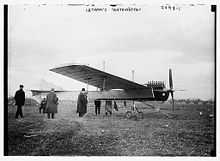Antoinette VII
| VII | |
|---|---|
| | |
| Antoinette VII example showing seating arrangement for two | |
| Role | Experimental aircraft |
| Manufacturer | Antoinette |
| Designer | Léon Levavasseur |
| First flight | 1909 |
|
| |
The Antoinette VII was an early French aircraft, flown in 1909.
History
The VII was a further development of the Antoinette IV, with increased engine power and using a wing warping system developed by Levavasseur for the Antoinette V in place of the Antoinette IV's ailerons.
With this aircraft, Levavasseur hoped that Antoinette test pilot Hubert Latham would be able to make the crossing of the English Channel that he had previously attempted in the Antoinette IV and claim the Daily Mail prize then on offer. As it happened, the Antoinette VII's first flight took place on 25 July 1909, the same day that Louis Blériot succeeded in crossing the channel in his Blériot XI. Undaunted, Latham made the attempt anyway on 27 July. Unfortunately, the result was the same, with Latham making a forced landing this time within sight of the English coast only 1.6 km (0.99 mi) away. He and the aircraft were rescued by HMS Russell.

The following month, Latham flew the same aircraft at the Grande Semaine d'Aviation de la Champagne, winning the prize for altitude (155 m, 509 ft) and coming second in the contest for the fastest circuit, with a speed of 68.9 km/h, 42.8 mph[1]
Specifications
General characteristics
- Crew: one, pilot (later versions after 1910 could accommodate one passenger)
- Length: 11.50 m (37 ft 9 in)
- Wingspan: 12.80 m (42 ft 0 in)
- Height: 3.00 m (9 ft 10 in)
- Wing area: 50 m2 (538 ft2)
- Gross weight: 590 kg (1,300 lb)
- Powerplant: 1 × Antoinette 8V, 37 kW (50 hp) each
Performance
- Maximum speed: 70 km/h (44 mph)
See also
External links
References
| Wikimedia Commons has media related to Antoinette VII. |
- ↑ Gibbs-Smith, C.H. (2003). Aviation. London: NMSO. p. 176.
- Taylor, Michael J. H. (1989). Jane's Encyclopedia of Aviation. London: Studio Editions. p. 63.
- World Aircraft Information Files. Brightstar Publishing: London. File 889 Sheet 63.
| ||||||||||
| ||||||||||||||||||||||